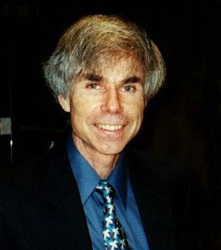 The Experience Indiana Speakers and Artists Series invites the Wabash community to two public talks by author and professor Douglas Hofstadter. Professor Hofstadter will give a public lecture entitled "Creativity and Analogy on Thursday, April 3 at 8 p.m. in Hays Hall, Room 104, followed by a Math and Computer Science colloquium on Friday, April 4 at noon in Baxter Hall, Room 101.
The Experience Indiana Speakers and Artists Series invites the Wabash community to two public talks by author and professor Douglas Hofstadter. Professor Hofstadter will give a public lecture entitled "Creativity and Analogy on Thursday, April 3 at 8 p.m. in Hays Hall, Room 104, followed by a Math and Computer Science colloquium on Friday, April 4 at noon in Baxter Hall, Room 101.
Copies of Douglas Hofstadter’s books, Gödel, Escher, Bach: an Eternal Golden Braid and I am a Strange Loop, are free to members of the Wabash community through the generous support of the Lecture Committee. Books are on a first come first serve basis outside Armory 112. He will also spend time in Wabash mathematics and philosophy classes.
Douglas Hofstadter is College Professor of Cognitive Science and Computer Science at Indiana University, where he also directs the Fluid Analogies Research Group, nicknamed "FARG," at the Center for Research on Concepts and Cognition. For roughly 25 years, the FARGonauts have been making computational models of our human concepts and categories, the premise being that if and when these mini-concepts achieve the holy grail of "fluidity," creative analogy making will be an outcome.
Hofstadter’s interests concerning the human mind are varied, ranging from errors as a window on the mind to the mechanisms of creativity to the nature of consciousness (see I Am a Strange Loop, his 2007 book). Currently his most active goal is to reveal how analogy-making lies at the base of all human thought, which he writes about in "Analogy as the Core of Cognition."
Hofstadter has a lifelong love for languages, and has written a tome about translation, analogies, constraints, and creativity, plus translated many poems and two novels into English. He has also spent much time doing art and music.
From 1981 to 1983, taking over from Martin Gardner’s incomparable "Mathematical Games" column, Hofstadter wrote the free-ranging "Metamagical Themas" column for Scientific American, from which a book of that title was later created.
Hofstadter received his doctorate in physics from the University of Oregon in 1975, and his thesis project led him to discover that crystal electrons in magnetic fields have a beautiful self-similar energy spectrum, the graph of which has since been dubbed the "Hofstadter butterfly." A couple of decades after his Ph.D., he started avidly exploring the astonishing role played by irrational analogical leaps in progress in physics, and he plans eventually to write a book on the topic.
In the early 1960’s, Douglas Hofstadter majored in mathematics at Stanford, and it was his passion for number theory and logic that led him eventually to writing the book for which he is best known, Gödel, Escher, Bach: an Eternal Golden Braid (1980 Pulitzer Prize award). He is presently focused on the discovery process in mathematics.